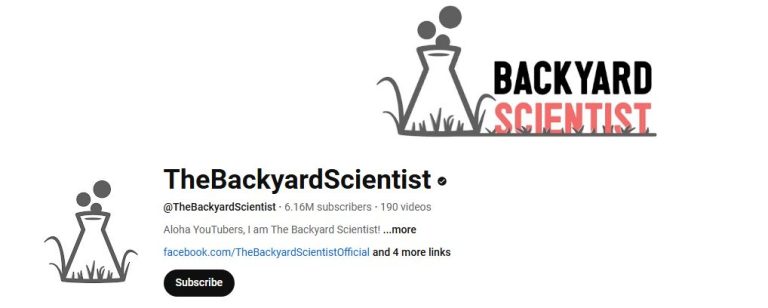This barefoot Florida native has been turning heads—and blowing them off, figuratively—with his backyard experiments that are both educational and explosive in an era when science frequently feels sterilized behind institutional walls. By pouring molten aluminum into watermelons, creating supersonic vortex cannons, and posing the kinds of questions that most people stop asking after they grow up, Kevin Kohler, who has over 6 million YouTube subscribers and is simply known as The Backyard Scientist, has become a hugely popular face of do-it-yourself science.
Kohler, who is remarkably out of the ordinary and unapologetically audacious, has established his online reputation on curiosity and spectacle alone. Since its launch in 2013, his channel has undergone significant change, progressing from simple firecracker tests to intricate experiments that push the limits of do-it-yourself science. He’s created a genre that’s part Jackass, part MythBusters, and completely irresistible, with everything from laser-guided bottle rockets to freeze rays.
Profile: Kevin Kohler – The Backyard Scientist
| Attribute | Detail |
|---|---|
| Full Name | Kevin Kohler |
| YouTube Channel | TheBackyardScientist |
| Followers | 6.15 million+ (as of April 2025) |
| Notable Videos | “Molten Aluminum from 50 Feet,” “Supersonic Nerf Cannon” |
| Education | Self-taught; background in marine biology |
| Location | Florida, United States |
| Specialty | DIY science, explosive experiments, slow-motion physics demos |
| @thebackyardscientist_ | |
| Merch & Book | “The Backyard Scientist Series One: 25 Experiments for Kids” |
| Known For | Combining dangerous materials with scientific principles |
Explosion at a Time: Engineering Excitement
Thermite, leaf blowers, and Tupperware are just a few examples of the commonplace objects that Kohler inventively repurposes to turn suburban peace into a dynamic testing ground. His videos are especially inventive because they analyze the why behind scientific phenomena rather than just showing what happens. They frequently pause to explain scientific phenomena using charts, models, or a high-speed camera that records the action frame by frame.
A new generation of students who might not have connected with traditional classroom lectures have been significantly inspired by The Backyard Scientist, which is remarkably successful at bridging the gap between entertainment and education. He has reimagined what hands-on science can look like by fusing realistic visuals with heart-pounding setups, especially for students who learn best online.
Why It Operates: The Mayhem’s Formula
Like a swarm of bees operating in a well-organized chaos, Kohler’s process seems impromptu but adheres to a systematic pattern. After posing the ridiculous query, “Can aluminum explode if poured onto a wasp nest?” he provides a scientific explanation. The spectacle alone is beautiful, but so is the way that real-world physics is presented in ways that are instantly comprehensible.
His narrative produces moments of suspense and clarity through deliberate pacing and well-timed slow-motion shots. The lesson is never lost in the chaos, but rather is enhanced by it. He frequently uses analogies to clarify difficult concepts, such as “this vortex cannon is like Thor’s hammer but with air.” He is especially skilled at giving abstract ideas a tangible feel.
The DIY Science Movement: Driven by Curiosity and Fire
Kevin’s ascent serves as an example of organic virality in the context of international science communication. Kohler’s content thrives on authenticity and experimentation, both literally and figuratively, in contrast to institutionally supported educational channels. Because of his engaging style and unadulterated enthusiasm, educators, tech companies, and STEM influencers have all shared his videos.
Creators like The Backyard Scientist have influenced how we learn—and love—science over the past ten years as YouTube, TikTok, and Instagram Reels have emerged as the new classrooms. His art highlights a broader trend: from structured education to self-directed learning driven by innovators who don’t mind breaking a few rules (or watermelons) along the way.
Prospects for the Backyard Lab in the Future
Kohler’s unafraid curiosity makes him more than just a viral sensation in the years to come, as educational content continues to move online. He embodies a broader trend of “citizen scientists”—people who are expanding the frontiers of knowledge not in academic laboratories but rather in backyards, garages, and gardens.
He is creating the foundation for an educational model that is both incredibly engaging and incredibly accessible by fusing excellent production with thought-provoking lessons. The Backyard Scientist is an invitation to ask more questions and to be less afraid, regardless of whether you’re a middle school student, a physics major, or just an inquisitive adult who enjoys things that go boom.


